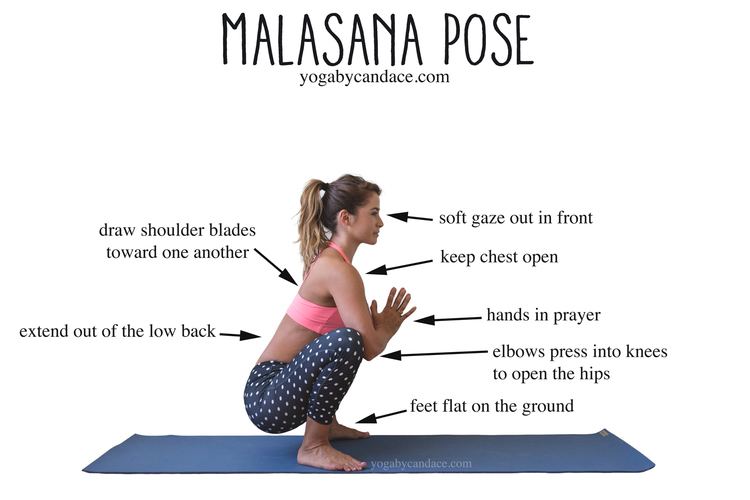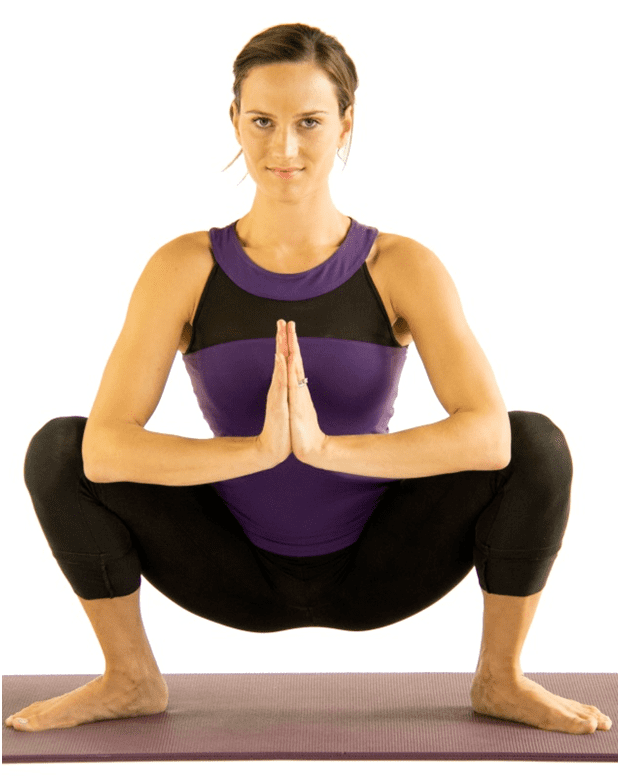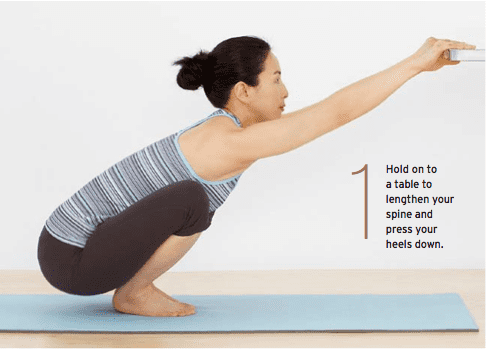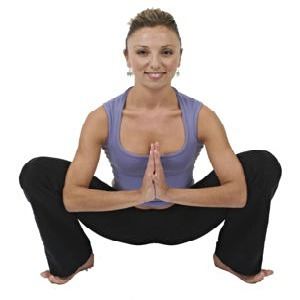Stretches Ankle, Groin, Back torso Also known as Garland pose | Pose type Standing | |
 | ||
Note Consult a doctor before beginning an exercise regime Preparatory poses Baddha Koṇāsana, Virasana, Upavistha Konasana Follow-up poses Adho mukha śvānāsana, Uttanasana, Bhujangasana Similar Uttanasana, Baddha Koṇāsana, Adho mukha śvānāsana, Utkatasana, Bālāsana | ||
Mālāsana, or malasana, is a term for various squatted āsanas. The term is being used in various western transliterations, and may refer to various asanas, all involving a squatted position.
Contents

The term malasana is most commonly used for the "regular squat pose," also called upavesasana, in which the handpalms are folded together in the socalled namaskar mudra in front of the chest, and the feet are set wider apart, which resembles the traditional defecating position.

The mālāsana, or "Garland Pose", is used for two slightly different āsanas, either with the hands folded around the heels, or with the arms folded around the legs while holding the hands together at the back, also called kanchyasana ("golden belt pose").

The term mālāsana is also used in the Sritattvanidhi to describe the bhujapidasana, the "shoulder press", in which the hands are placed at the bottom, the body balancing on the hands, and the legs resting on the shoulders.

Etymology

Mālāsana is a compound of two Sanskrit terms, mālā and āsana, The transliteration and translation from Sanskrit to English gives rise to two different meanings or translations, since the Sanskrit "a" may be pronounced in two ways, the nuance of which is lost when the macron is left:
The English transliteration "mala" may refer to the following Sanskrit terms:
Three variant transliterations of "mālāsana" can be found in English:
Description
The term mālāsana may refer to four different asanas:
Upavesasana
The term malasana is most commonly used for the "regular squat pose," also called upavesasana, in which the handpalms are folded together in the socalled namaskar mudra in front of the chest, and the feet are set wider apart, which resembles the traditional defecating position.
This asana is a squat with heels flat on the floor and hip-width apart (or slightly wider if necessary), toes pointing out on a diagonal. The torso is brought forward between the thighs, elbows are braced against the inside of the knees, and the hands press together in front of the chest in Añjali Mudrā.
The Yoga Journal says the malasana stretches the ankles, groins and back, tones the belly. It also cautions about using the asana when there are lower back or knee injuries.
Mālāsana I/Kanchyasana
In the first variant, the hands are folded together at the back, while the chin touches the floor. This asana is also called kanchyasana ("golden belt pose").
Mālāsana II
In the second variant, the feet are placed at the floor, one takes a squatted position, folds the hands around the heels, and touches the floor with the chin.
Bhujapidasana
The Sritattvanidhi, a 19th-century book on a number of subjects including asanas, gives a different picture for an āsana called mālāsana at plate no.44. In this picture, the palms are placed flat on the floor, arm stretched upright, and the whole body balancing on the hands, while the legs are held close to the body, with the heels hanging down from a position close to the shoulders. This asana is also known as bhujapidasana, the "shoulder press." The mālāsana can be used as a preparation for the bhujapidasana.
